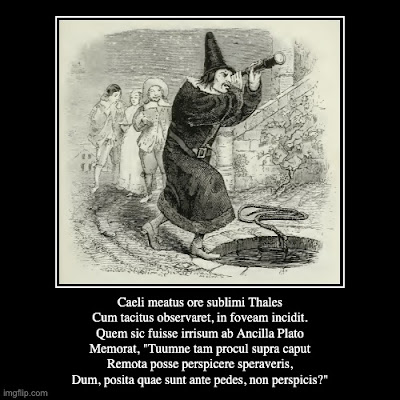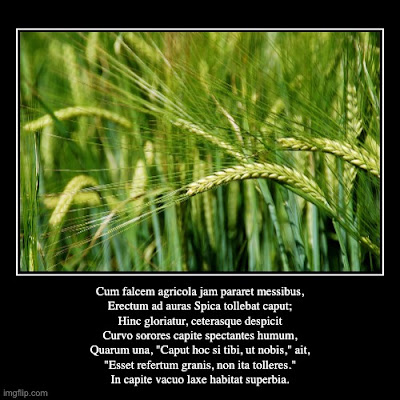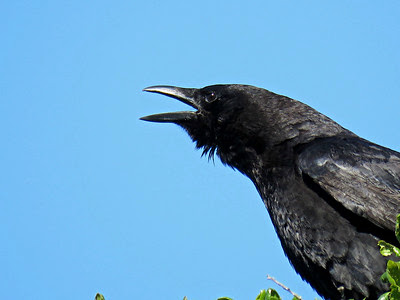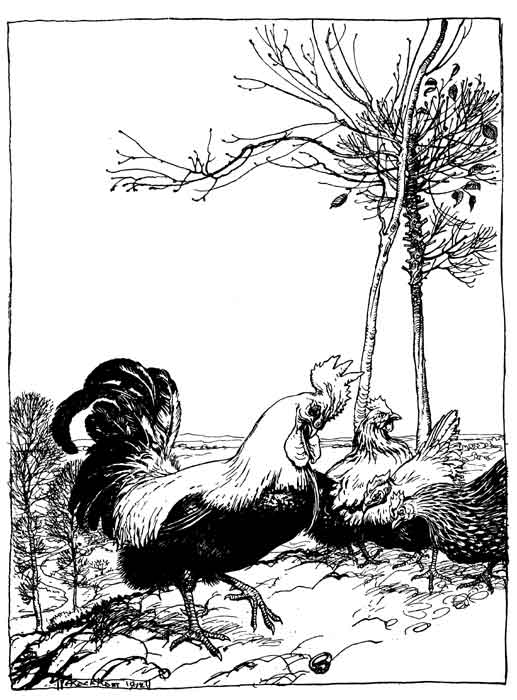This project has moved to a blog of its own:
Fabulae Aesopi.
As part of this work on
the Latin fables of Desbillons (see
this post for more info), I'm reading some poems with Hector Tapia, and in this post I'll report on two poems we worked on this week: Mors et Rusticus and Myrtus et Quercus.
The first poem is one found in the
classical Aesopic tradition; sometimes the emphasis is on the fact that he is an old man, and sometimes on the fact that he is miserable. In Desbillons, he is both:
senex miser.
II.11 Mors et RusticusFascem lignorum Rusticus, senex miser,
Portabat aegre; longiore sed via
Fractus, victusque, abjecit infelix onus.
Mortem invocavit. Mors advenit. Tum senex:
Fascem, ait, in humeros hunc mihi reponas precor.
Here is the poem written out in English prose order to help in reading:
Rusticus,
senex miser,
aegre portabat
fascem lignorum,
sed fractus et victus
longiore via,
abjecit infelix onus;
invocavit Mortem.
Mors advenit.
Tum senex ait,
"Precor:
reponas hunc fascem
mihi in humeros."
Reading through the poem with Hector helped me see that the adjective
infelix is ambiguous: it could refer to the subject of the verb (giving the adjective an adverbial quality), or it could refer to the
onus, as a kind of transferred epithet: because the man is unhappy, his burden becomes unhappy. I think I like that meaning best!
The meter is iambic, and here is some help with the meter (for more about iambic meter, see
the post about Desbillons 1.1).
Fascem · ligno · rum Rus · ticus · senex · miser
Porta · bat ae · gre lon · gio · re sed · via
Fractus · victus · qu~ abje · cit in · felix · onus;
Mort~ in · voca · vit. Mors · adve · nit. Tum · senex,
Fasc~ ait · in hume · ros hunc · mihi re · ponas · precor.
You can find
illustrations for the fable here; as you can imagine, this is one that artists enjoy, as it offers a chance to depict Death personified. Here's one by
Francis Barlow, and I used
imgflip to make it a graphic:
The second poem is a familiar Aesopic theme, and for a specific source, Desbillons cites the French fabulist Le Noble.
XIII.11 Myrtus et QuercusPusilla Myrtus invidebat Quercui,
Sed agricolarum repetitis mox ictibus
Hanc sauciari, denique everti videns,
Humilior etiam optavit esse, quam fuit.
Dejicere summos grandibus sors invida
Gaudet ruinis, dum infimi tuto latent.
Here is the poem written out in English prose order to help in reading:
Pusilla Myrtus
invidebat Quercui,
sed mox videns
hanc [Quercum]
sauciari
repetitis ictibus agricolarum
denique everti,
optavit
esse etiam humilior quam fuit.
sors invida
gaudet dejicere summos
ruinis grandibus,
dum infimi
latent tuto.
The whole "story" part of the poem is told in just a single sentence! There's an imperfect verb to set the scene, a participle that shifts into the actual events of the story, and then a perfect verb for the finale. In the epimythium, the word
sors is the key, and it really comes out of nowhere: it's like
sors was the invisible actor driving the events of the story, and, like the myrtle,
sors is
invida, but in this case that envy has real consequences! You can read about
sors in the Latin dictionary; it's a word really impossible to translate into English. In this case, I'd be tempted to translate it as Fortune.
The meter is iambic, and here is some help with the meter (for more about iambic meter, see
the post about Desbillons 1.1).
Pusil · la Myr · tus in · vide · bat Quer · cui,
Sed ag · ricola · rum repe · titis · mox ic · tibus
Hanc sau · cia · ri, de · niqu~ e · verti · videns,
Humili · or eti · ~ opta · vit es · se, quam · fuit.
Dejice · re sum · mos gran · dibus · sors in · vida
Gaudet · rui · nis, d~ in · fimi · tuto · latent.
And while the myrtle may be scrawny compared to an oak, she can be pretty too! Here's a picture from Italy that I found at
Wikimedia:
Meanwhile, for more Desbillons, here are the
other poems I've posted so far here at the blog. :-)











_-_WMI-mAppiaM_2016_-_gIMG_2130.jpeg)



